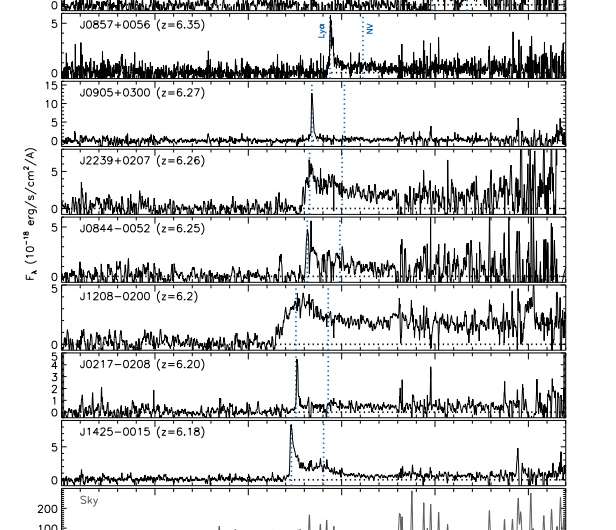Reduced spectra of the first set of eight quasars and possible quasars discovered in this work, displayed in decreasing order of redshift. The object name and the estimated redshift are indicated at the top left corner of each panel. The blue dotted lines mark the expected positions of the Lyα and N V λ1240 emission lines, given the redshifts. The spectra were smoothed using inverse-variance weighted means over 3 – 9 pixels (depending on the S/N), for display purposes. The bottom panel displays a sky spectrum, as a guide to the expected noise. Credit: Matsuoka et al., 2017.
(Phys.org)—A team of astronomers led by Yoshiki Matsuoka of the National Astronomical Observatory of Japan (NAOJ) has detected a treasure trove of new high-redshift quasars (or quasi-stellar objects) and luminous galaxies. The newly found objects could be very important for our understanding of the early universe. The findings were presented Apr. 19 in a paper published on arXiv.org.
High-redshift quasars and galaxies (at redshift higher than 5.0) are useful probes of the early universe in many respects. They offer essential clues on the evolution of the intergalactic medium, quasar evolution, early supermassive black hole growth, as well as evolution of galaxies through cosmic times. Generally speaking, they enable scientists to study the universe when it looked much different than it does today.
Recently, Matsuoka's team has presented the results from the Subaru High-z Exploration of Low-Luminosity Quasars (SHELLQs) project, which uses multi-band photometry data provided by the Hyper Suprime-Cam (HSC) Subaru Strategic Program (SSP) survey. HSC is a wide-field camera installed on the Subaru 8.2 m telescope located at the summit of Maunakea, Hawaii and operated by NAOJ. The researchers selected nearly 50 photometric candidates from the HSC-SSP source catalog and then observed them with spectrographs on the Subaru Telescope and the Gran Telescopio Canarias (GTC), located on the island on the Canary Island of La Palma, Spain.
The observations resulted in the identification of 24 new quasars and eight new luminous galaxies at redshift between 5.7 and 6.8.
"We took optical spectra of 48 candidates with GTC/OSIRIS and Subaru/FOCAS, and newly discovered 24 quasars and 8 luminous galaxies at 5.7 < z ≤ 6.8," the paper reads.
According to the study, the newly detected quasars have lower luminosity than most of the previously known high-redshift quasi-stellar objects, in contrast to the new galaxies, which have extremely high luminosity when compared to other galaxies found at similar redshift.
The quasar with the highest redshift (6.8) described in the paper received designation J1429 − 0104, while the one with the lowest redshift (5.92) was named J0903 + 0211. Among the new galaxies, J1628 + 4312 was found at the highest redshift (6.03) and J2237 − 0006 at the lowest (5.77). J2237 − 0006 is also the most luminous newly found galaxy.
Meanwhile, the researchers revealed that the SHELLQs project continues, and more new quasars are being discovered, which will be reported in forthcoming papers.
"Further survey observations and follow-up studies of the identified objects, including the construction of the quasar luminosity function at z ∼ 6, are ongoing," they wrote in the paper.
The authors also noted that they plan to conduct follow-up observations of the newly discovered quasars and galaxies at various wavelengths from sub-millimeter/radio to X-ray. Several of these objects have already been observed with the Atacama Large Millimeter/submillimeter Array (ALMA) in Chile, near-infrared spectrographs on the Gemini telescope, located in Hawaii and the Very Large Telescope (VLT), also in Chile.
More information: Subaru High-z Exploration of Low-Luminosity Quasars (SHELLQs). II. Discovery of 32 Quasars and Luminous Galaxies at 5.7 < z < 6.8, arXiv:1704.05854 [astro-ph.GA] arxiv.org/abs/1704.05854
Abstract
We present spectroscopic identification of 32 new quasars and luminous galaxies discovered at 5.7 < z < 6.8. This is the second in a series of papers presenting the results of the Subaru High-z Exploration of Low-Luminosity Quasars (SHELLQs) project, which exploits the deep multi-band imaging data produced by the Hyper Suprime-Cam (HSC) Subaru Strategic Program survey. The photometric candidates were selected by a Bayesian probabilistic algorithm, and then observed with spectrographs on the Gran Telescopio Canarias and the Subaru Telescope. Combined with the sample presented in the previous paper, we have now identified 64 HSC sources over about 430 deg2, which include 33 high-z quasars, 14 high-z luminous galaxies, 2 [O III] emitters at z ~ 0.8, and 15 Galactic brown dwarfs. The new quasars have considerably lower luminosity (M1450 ~ -25 to -22 mag) than most of the previously known high-z quasars. Several of these quasars have luminous (> 10^(43) erg/s) and narrow (< 500 km/s) Ly alpha lines, and also a possible mini broad absorption line system of N V 1240 in the composite spectrum, which clearly separate them from typical quasars. On the other hand, the high-z galaxies have extremely high luminosity (M1450 ~ -24 to -22 mag) compared to other galaxies found at similar redshift. With the discovery of these new classes of objects, we are opening up new parameter spaces in the high-z Universe. Further survey observations and follow-up studies of the identified objects, including the construction of the quasar luminosity function at z ~ 6, are ongoing.
© 2017 Phys.org
























